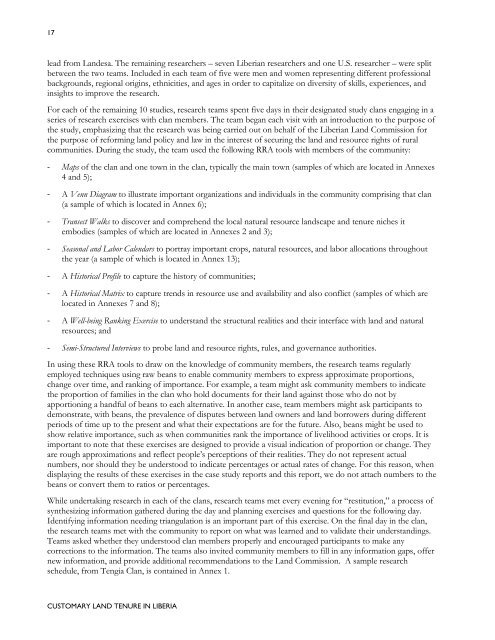Customary Land Tenure in Liberia - Land Tenure and Property ...
Customary Land Tenure in Liberia - Land Tenure and Property ...
Customary Land Tenure in Liberia - Land Tenure and Property ...
Create successful ePaper yourself
Turn your PDF publications into a flip-book with our unique Google optimized e-Paper software.
17<br />
lead from <strong>L<strong>and</strong></strong>esa. The rema<strong>in</strong><strong>in</strong>g researchers – seven <strong>Liberia</strong>n researchers <strong>and</strong> one U.S. researcher – were split<br />
between the two teams. Included <strong>in</strong> each team of five were men <strong>and</strong> women represent<strong>in</strong>g different professional<br />
backgrounds, regional orig<strong>in</strong>s, ethnicities, <strong>and</strong> ages <strong>in</strong> order to capitalize on diversity of skills, experiences, <strong>and</strong><br />
<strong>in</strong>sights to improve the research.<br />
For each of the rema<strong>in</strong><strong>in</strong>g 10 studies, research teams spent five days <strong>in</strong> their designated study clans engag<strong>in</strong>g <strong>in</strong> a<br />
series of research exercises with clan members. The team began each visit with an <strong>in</strong>troduction to the purpose of<br />
the study, emphasiz<strong>in</strong>g that the research was be<strong>in</strong>g carried out on behalf of the <strong>Liberia</strong>n <strong>L<strong>and</strong></strong> Commission for<br />
the purpose of reform<strong>in</strong>g l<strong>and</strong> policy <strong>and</strong> law <strong>in</strong> the <strong>in</strong>terest of secur<strong>in</strong>g the l<strong>and</strong> <strong>and</strong> resource rights of rural<br />
communities. Dur<strong>in</strong>g the study, the team used the follow<strong>in</strong>g RRA tools with members of the community:<br />
- Maps of the clan <strong>and</strong> one town <strong>in</strong> the clan, typically the ma<strong>in</strong> town (samples of which are located <strong>in</strong> Annexes<br />
4 <strong>and</strong> 5);<br />
- A Venn Diagram to illustrate important organizations <strong>and</strong> <strong>in</strong>dividuals <strong>in</strong> the community compris<strong>in</strong>g that clan<br />
(a sample of which is located <strong>in</strong> Annex 6);<br />
- Transect Walks to discover <strong>and</strong> comprehend the local natural resource l<strong>and</strong>scape <strong>and</strong> tenure niches it<br />
embodies (samples of which are located <strong>in</strong> Annexes 2 <strong>and</strong> 3);<br />
- Seasonal <strong>and</strong> Labor Calendars to portray important crops, natural resources, <strong>and</strong> labor allocations throughout<br />
the year (a sample of which is located <strong>in</strong> Annex 13);<br />
- A Historical Profile to capture the history of communities;<br />
- A Historical Matrix to capture trends <strong>in</strong> resource use <strong>and</strong> availability <strong>and</strong> also conflict (samples of which are<br />
located <strong>in</strong> Annexes 7 <strong>and</strong> 8);<br />
- A Well-be<strong>in</strong>g Rank<strong>in</strong>g Exercise to underst<strong>and</strong> the structural realities <strong>and</strong> their <strong>in</strong>terface with l<strong>and</strong> <strong>and</strong> natural<br />
resources; <strong>and</strong><br />
- Semi-Structured Interviews to probe l<strong>and</strong> <strong>and</strong> resource rights, rules, <strong>and</strong> governance authorities.<br />
In us<strong>in</strong>g these RRA tools to draw on the knowledge of community members, the research teams regularly<br />
employed techniques us<strong>in</strong>g raw beans to enable community members to express approximate proportions,<br />
change over time, <strong>and</strong> rank<strong>in</strong>g of importance. For example, a team might ask community members to <strong>in</strong>dicate<br />
the proportion of families <strong>in</strong> the clan who hold documents for their l<strong>and</strong> aga<strong>in</strong>st those who do not by<br />
apportion<strong>in</strong>g a h<strong>and</strong>ful of beans to each alternative. In another case, team members might ask participants to<br />
demonstrate, with beans, the prevalence of disputes between l<strong>and</strong> owners <strong>and</strong> l<strong>and</strong> borrowers dur<strong>in</strong>g different<br />
periods of time up to the present <strong>and</strong> what their expectations are for the future. Also, beans might be used to<br />
show relative importance, such as when communities rank the importance of livelihood activities or crops. It is<br />
important to note that these exercises are designed to provide a visual <strong>in</strong>dication of proportion or change. They<br />
are rough approximations <strong>and</strong> reflect people‟s perceptions of their realities. They do not represent actual<br />
numbers, nor should they be understood to <strong>in</strong>dicate percentages or actual rates of change. For this reason, when<br />
display<strong>in</strong>g the results of these exercises <strong>in</strong> the case study reports <strong>and</strong> this report, we do not attach numbers to the<br />
beans or convert them to ratios or percentages.<br />
While undertak<strong>in</strong>g research <strong>in</strong> each of the clans, research teams met every even<strong>in</strong>g for “restitution,” a process of<br />
synthesiz<strong>in</strong>g <strong>in</strong>formation gathered dur<strong>in</strong>g the day <strong>and</strong> plann<strong>in</strong>g exercises <strong>and</strong> questions for the follow<strong>in</strong>g day.<br />
Identify<strong>in</strong>g <strong>in</strong>formation need<strong>in</strong>g triangulation is an important part of this exercise. On the f<strong>in</strong>al day <strong>in</strong> the clan,<br />
the research teams met with the community to report on what was learned <strong>and</strong> to validate their underst<strong>and</strong><strong>in</strong>gs.<br />
Teams asked whether they understood clan members properly <strong>and</strong> encouraged participants to make any<br />
corrections to the <strong>in</strong>formation. The teams also <strong>in</strong>vited community members to fill <strong>in</strong> any <strong>in</strong>formation gaps, offer<br />
new <strong>in</strong>formation, <strong>and</strong> provide additional recommendations to the <strong>L<strong>and</strong></strong> Commission. A sample research<br />
schedule, from Tengia Clan, is conta<strong>in</strong>ed <strong>in</strong> Annex 1.<br />
CUSTOMARY LAND TENURE IN LIBERIA

















